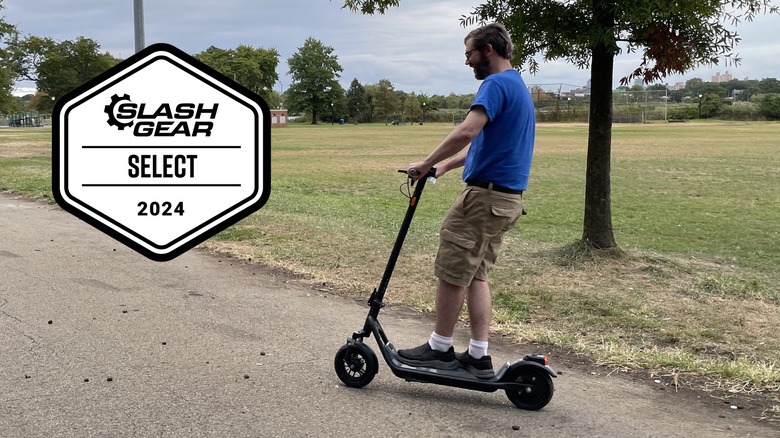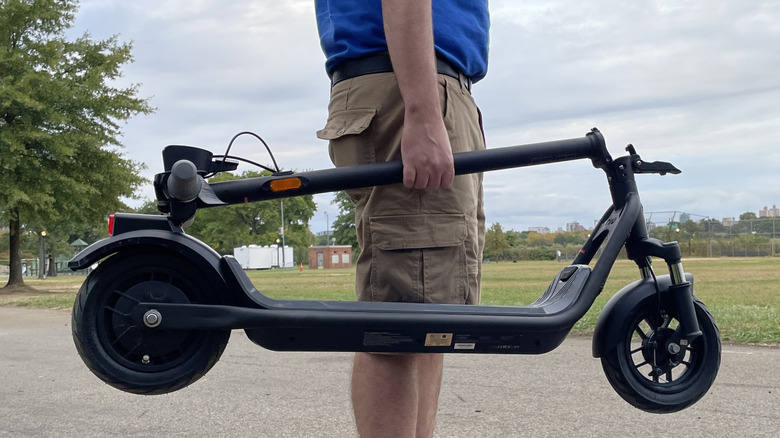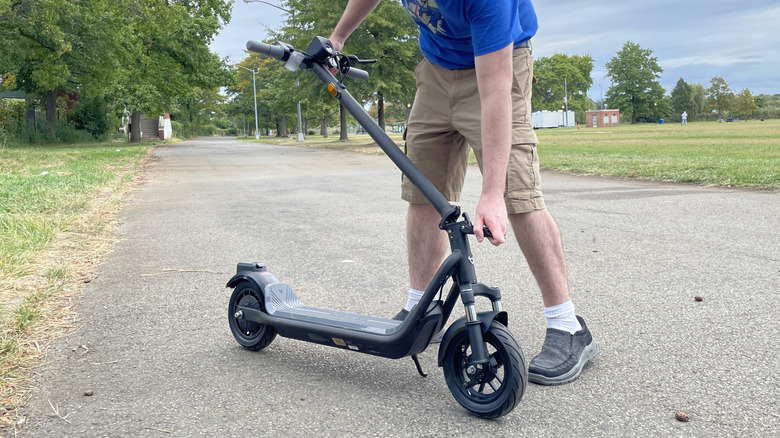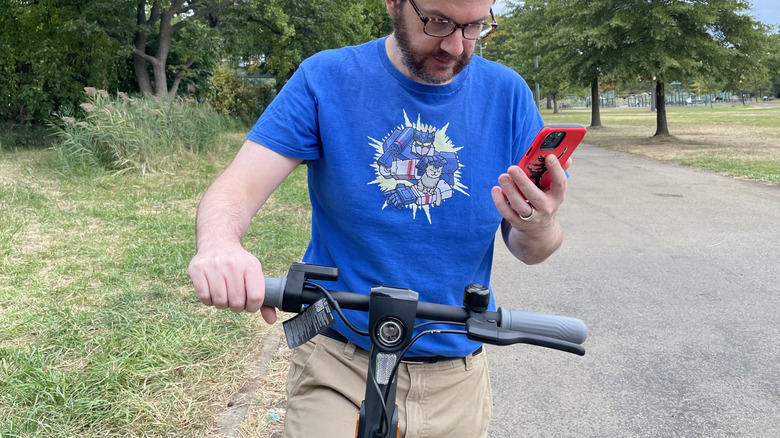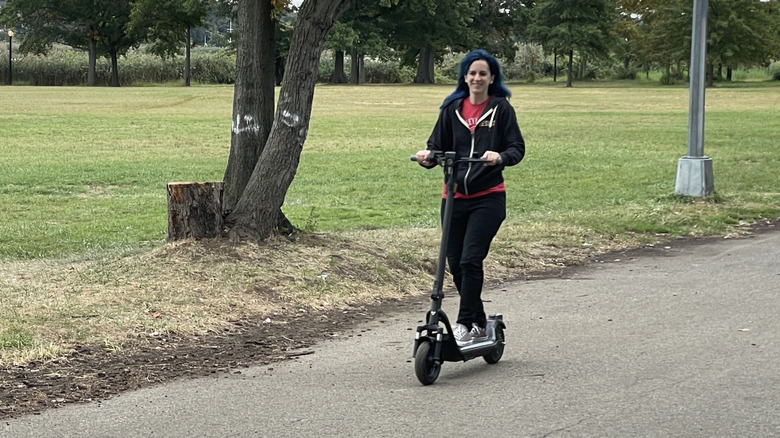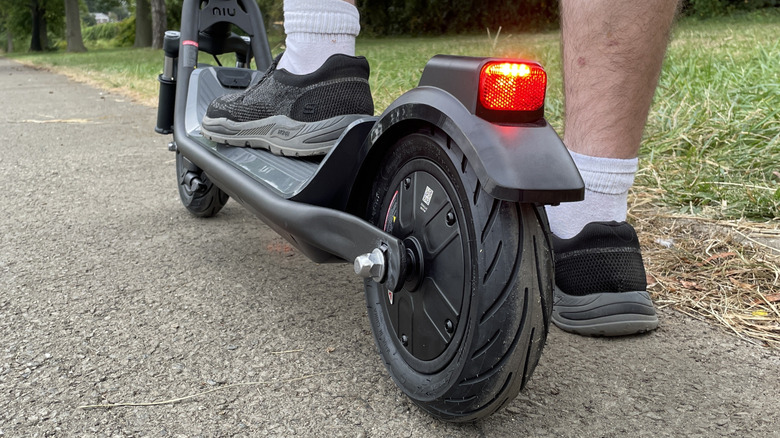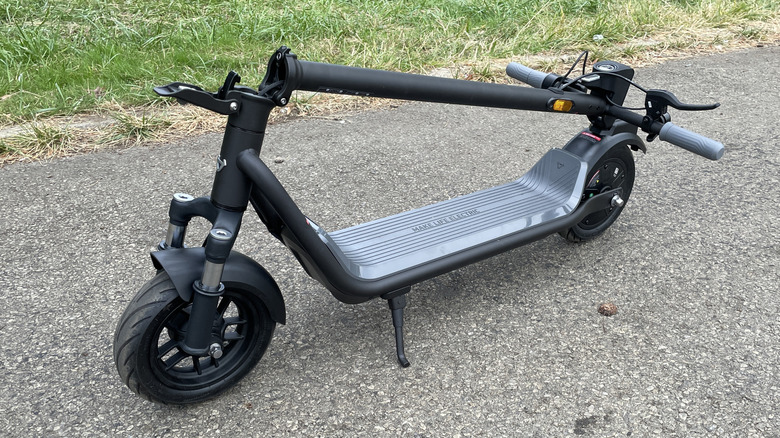Niu KQi 100P Review: A Cheaper, Easier, Better Electric Scooter
- Easy to set up and align properly
- Folds and unfolds easily but securely
- Feels good to ride and even handles grass well
- Lots of small but convenient features
- Battery life is solid and holds up well in use and in storage
- Pretty heavy and clunky when space is limited
- App setup is a bit awkward
- Some features require an app connection
Niu's KQi 100P is being billed as a budget electric scooter, and the sub-$350 price point does place it firmly in that category. So it should hold its own among a number of price point peers, right? Well, yes, it does. What's more unexpected is that it kind of also stands toe-to-toe with more expensive models. Like the Razor Icon or even possibly the Segway-Ninebot eKickScooter E2 Pro.
This is a scooter that you can simply take out of the box and ride, or you can get the app involved to effectively "unlock" additional features and more finely-tuned options. But it also does a bunch of really smart little things.
No one aspect is mind-blowing or spectacular on its own, but they add up to something fairly impressive. The full package is something rare and special, like finding out there's a free refill on ice cream or getting head-booped by two cats at the same time. What I'm trying to say is that, for what it is, the KQi 100P is pretty dang nice. Niu provided a KQi 100P for the purpose of this review.
Blissfully easy assembly
Now, I'll admit my experiences with electric scooters don't extend to every model or manufacturer on the market, but getting the KQi 100P set up felt like a breath of fresh air compared to the Razor Icon I looked at last time. Or I guess it's more apt to say it was a breath of fresh air when what I'd inhaled earlier wasn't particularly easy to process.
Unpacking the KQi 100P is fairly simple, with the box just containing the body and handlebars along with prepackaged documentation and tools to go with it — as well as packing materials, of course. There is a little awkwardness due to the bars being connected (not actually affixed) to the body already via wires, but it's perfectly manageable. Aside from unfolding and locking the stem in place, all you really have to do is drop the handlebars into the top and use the included T-handled Allen wrench to drive in six screws.
This is — and I cannot stress this enough — so much easier than putting the popular-branded Razor Icon together. Properly lining up the handlebars is a breeze since those six screws can only go in properly when things are aligned correctly, meaning you don't have to eyeball (and cross your fingers) during alignment. No need to connect wires, no wrestling with several cumbersome metal parts, or anything like that. Though it's still recommended that you plug in and fully charge the scooter before taking it for a spin.
Getting ready to ride
Once the KQi 100P is put together and charged you're technically ready to go. However, there is a companion app that Niu also recommends using, available on both the App Store and through Google Play. I ran into trouble getting the included QR code to work on my iPhone, but a quick App Store search took care of the problem.
Connecting the app to the scooter is also relatively simple, though you'll have to make an account first if you don't already have one. Turn on the scooter and open the app, tap the appropriate button to pair the two via Bluetooth, and then either watch or skip the app's tutorial to get started. At least, that's how it's supposed to go. My experience was more the app getting stuck loading the tutorial, exiting, it not pairing with the scooter, then me tapping the Bluetooth button on the scooter's app page to manually connect. Not too bad, but not as smooth as intended (or expected), either.
Pairing isn't strictly necessary as the KQi 100P will still run without the app, but it's the only way to access certain features. Whether or not that matters depends on how much use you expect to get out of said features — and how you feel about a hard 9 mph speed limitation.
Why the app helps
With the KQi 100P connected to the app (and maintaining that connection), you can jump into the menus to better customize your experience. Turning on Dynamic Mode opens up additional options for speedier acceleration, as well as the choice to reduce the scooter's speed to as little as 3 mph or increase it up to 17 mph. Digging into the options also lets you toggle the speed measurements between kph and mph.
The app also lets you choose whether or not the motor will engage at a full stop, how fast the scooter has to go before the motor will function, and whether to let the battery charge to 100-percent or make it stop between 80- or 95-percent in increments of five (to preserve battery health). It can also be used to manage regenerative braking to feed some of the energy from stopping back into the battery, with larger energy transfer resulting in harder braking, so be cautious.
What surprised me the most was the Auto Cruise option. It's basically just cruise control, but for a scooter, with the KQi 100P automatically handling your speed if you maintain the same rate for five seconds or more. Then, of course, braking or moving the accelerator will cause it to shut off.
Riding in the real world
Outside of all the setup and app stuff, the KQi 100P is surprisingly nice for being something intentionally priced for affordability. The construction feels sturdy, the tires are nice and big, the front shocks are nice, and it makes for an overall smooth ride.
There are a lot of little things about it I prefer as well. There's only one physical button on the handlebars — the Power button — so there's no need to split focus between what's ahead and what's on the screen. The handbrake and accelerator are easy to find without looking down. The front wheel does this thing I love where it sort of gently guides itself back to a straight forward neutral position once your turning radius is small enough. It even did a surprisingly good job driving over grass when I took an unexpectedly wide turn. The scooter kept rolling and I was still balancing, so I figured I'd see if I could simply drive it back to asphalt and I did with no problems.
I also love the simple cleverness of the locking mechanism for the stem and handlebars. It's super easy to unlock the main latch and pull it down until the stem disconnects, then fold it back and lock it down above the rear tire. It's also really easy to unlock the handlebars from the rear, fold the stem into place, then lock it back down. But there are like three actual locking points that keep the stem upright, only one of which will allow the others to move, so there's no risk of the KQi 100P collapsing on you. As long as you engage the locks completely, of course.
Weight, Movement, and Status
Despite the fact that the KQi 100P is actually heavier than the Razor Icon (about 36 pounds versus around 26.5, going by our home scale), it's actually a little easier to physically manage. The handlebars locking in when the scooter is folded up are a massive help because you don't have to fight against physics in addition to gravity when carrying it, for one thing.
Locked-in handlebars also make the KQi 100P a little easier to roll along rather than carry — though it's still a bit big and heavy to roll it for very long while collapsed. That said, even though the handlebars themselves don't fold in (I really wish they did, too), Niu's new scooter manages to feel smaller than that Razor Icon I keep talking about. I'm pretty sure it's not, but its folded up mass is much more evenly distributed and you don't fold up the front wheel along with the stem and handlebars. Still a bit clunky to try and store in a small NYC apartment, but somehow less of an imposition than that other scooter I keep making comparisons with.
This one's weird but I'm also a fan of how the KQi 100P depicts its charging status. While it's plugged in the handlebar display shows a handy series of bars along the bottom of the screen to denote charge level, which is expected and appreciated. But what's also really useful is the charging cable itself — or rather the power supply (the rectangular box in the middle of the power cord) — which will change from red to green once charging is finished. It's simple, but effective. That's kind of the KQi 100P in a nutshell, really.
Verdict
Messing around with the Niu KQi 100P has been something of a pleasant surprise. I know I keep drawing comparisons with the Razor Icon but the difference between the two really is night and day. At least as far as ease of set up and ease of use are concerned.
It's baffling how this $349.98 scooter (as sold online in the Niu store) has been so much more enjoyable to put together, use, and tuck away than a $600 model, but that's how it is. At least for me. It's bigger and heavier, but due to the way it's designed to fold up it somehow feels easier to carry, roll, and tuck away. I feel like I'm watching physics defiance in action.
The functionality is a similar story. I'm positive there are aspects to the KQi 100P that big electric scooter enthusiasts will find lacking — maybe it's not fast enough, doesn't turn tight enough, or something. But I'm also confident that anyone looking for an affordable electric scooter that'll go from Point A to Point B without a fuss, maybe with a few added bells and whistles along the way, could do significantly worse.
